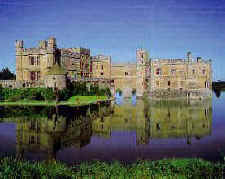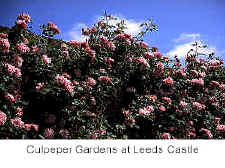Leeds Castle
Leeds, Kent, England
Historic Leeds Castle Links England, America
By June Rickey
11 Oct 1987
The Sunday Oklahoman, Page 01
 "Leeds - the loveliest castle as thus beheld in the whole world," wrote Lord
Conway, historian of castles.
"Leeds - the loveliest castle as thus beheld in the whole world," wrote Lord
Conway, historian of castles.
We arrived by
bus on a beautiful morning early in March. The mist hung lightly over the river Len,
giving the castle a dream-like quality. The castle sets like a precious jewel in the
middle of a small river surrounded by the green, softly-rolling hills of Kent in
southeastern England.
The "fairy tale" castle, one of England's oldest and most romantic, links
England to America from pre-colonial days to the present.
We entered the castle through the wine cellar, the oldest original part of the castle
and one of the few rooms we were allowed to photograph. Huge wooden casks lined the dim
cave-like chamber. According to the Domesday Book in 1086, wine already was being produced
at Leeds. Wine is again being made from vineyards on the castle estates.
Next was the Heraldry room, which depicts the long and intriguing history of Leeds. It
contains the coats of arms of all its former owners, from King Ethelbert IV in 857 to Lady
Baillie, its last owner. Portraits, miniatures and historical memorabilia of families
associated with Leeds from the 13th to the 19th century are displayed here.
Ledian or
Leed, the chief minister of Ethelbert IV, the
King of Kent, built a wooden structure on two islands in the middle of the river Len in
the year 857 as a fortress to protect his family. The castle was rebuilt in stone by a
Norman baron during the reign of William the Conqueror's youngest son, Henry I, almost 900
years ago.
In 1278, Leeds Castle was deeded to King Edward I and his queen. Edward adored Eleanor,
the lovely Spanish princess who saved his life after he was struck by an assassin's poison
arrow in Acre. Although he married her to protect the southern boundary of his French
possessions in Gascony, he grew to love her deeply and deeded Leeds to her as a token of
his devotion.
Eleanor died young and the heartbroken king was moved to write, "My harp is turned
to mourning, in life I loved her dearly, nor can I cease to love her in death."
Edward dedicated a chantry in the chapel to the memory of his beloved Eleanor where
mass was to be celebrated daily for her soul. This was done for hundreds of years after
his own death.
In 1299 King Edward I married Margaret, the sister of the French King, Philip III, for
political reasons. He again gave Leeds to his queen and began the tradition which was
followed for centuries, that of transferring ownership to the queen. Leeds became known as
the "ladies castle" and is called that today.
The last queen to receive Leeds as a dower from her husband was Catherine de
Valois,
queen of Henry V. She acquired the castle in 1422, made repairs and installed the bell and
clock in 1435. The clock still strikes the hour and the bell was last rung when Queen
Elizabeth II visited Leeds in 1981.
Two of the rooms open to the public have been restored to the way they were in the 15th
century during the reign of King Henry V and Queen Catherine. The furniture is made of the
same materials, by the same methods practiced then. Although the daybed and chair were
actually used, the bed was symbolic and never slept in. The queen received special guests
here. Luxurious silk damask in shades of coral, gold and green with the initials
"H" and "C" entwined with a lovers' knot embellish the bed, walls and
furniture.
The queen's bath is a small room with a fireplace, adjoining her bedroom. The bathtub
is a simple wooden tub draped and canopied with fine linens. A small stool, which sets
inside the tub for the queen to sit on as she bathed, is covered with linen to protect her
skin from the harsh wood surfaces.
The bath would be filled with herb-scented water carried up from the kitchen in wooden
buckets.
When King Henry V died, Catherine was a lively girl of 21 and she fell in love with
Owen Tudor, the handsome Welshman who looked after her dresses and jewels. Leeds was a
perfect place for a royal romance, with its extensive gardens and lovely setting on the
River Len.
When the pair's romance was discovered, the dowager queen and her lover were both
imprisoned. The queen eventually was released and Owen Tudor escaped. They had been
secretly married and their son, Edmund, Earl of Richmond, was the father of King Henry
VII. Thus began the Tudor dynasty which has been called the greatest of all the English
royal lines.
The queen's gallery is furnished with heavy oak furniture from different periods. A
pair of Brussels tapestries with biblical scenes hang on the walls along with a fine 16th
century triptych (three panel picture) of the St. Ursula legend.
The fireplace, carved in Kent ragstone, is flanked by high arched windows beneath a
finely-carved oak ceiling. It's easy to imagine a medieval queen with a long, flowing gown
and conical headdress sitting in front of the windows embroidering or awaiting her lover's
return.
King Henry VIII was Leeds' most famous owner. He went
there often and spent vast sums of money enlarging and improving the castle. The maiden's
tower was built about 1544 in preparation for the visit of Henry VIII 's first queen,
Catherine of Aragon, to house the Royal Maids of Honour.
Among the maids was Anne Boleyn, a Kentish girl from nearby Hever Castle. Anne became
Henry's second queen, and the mother of the future Queen Elizabeth I. Later, Anne was
sentenced to death for treason and beheaded at the Tower of London.
A jewel casket belonging to Anne Boleyn is on display in Leeds' Heraldry room.
Leeds Castle was deeded to Sir Anthony St. Leger by Henry VIII as a reward for
governing Ireland. Thus, Leeds passed out of royal ownership after having been a favorite
residence of medieval kings and queens for more than 300 years. Three queens were French
and brought with them the luxurious touches for which the French royalty is famous.
A descendant of St. Leger, Sir Warham St. Leger, was closely associated with Sir Walter
Raleigh, whose lifelong dream was to establish a new English nation in America.
 The castle's
association with America continued when one of its owners, Lord Culpeper, received a large
tract of land in Virginia for his help in getting the young Prince of Wales (later King
Charles II) out of England into exile in France in 1649.
The castle's
association with America continued when one of its owners, Lord Culpeper, received a large
tract of land in Virginia for his help in getting the young Prince of Wales (later King
Charles II) out of England into exile in France in 1649.
Culpeper 's son became governor of Virginia due to his vast land holdings. Culpeper 's
daughter, Catherine, married Thomas, fifth Lord of Fairfax, and Leeds was deeded to her
upon the death of her mother.
A Fairfax descendant hired young George Washington to survey his American holdings and
the two men formed a lifelong friendship, securing the link between America and Leeds.
Lord Fairfax attained such popularity in Virginia that it continued even after the
American Revolution. George Washington mourned Lord Fairfax's death at age 89,
affectionately calling him "the good old lord."
Leeds Castle remained in the Fairfax family until it was sold by a descendant in
Virginia in 1804. Leeds passed through many owners and fell into a state of disrepair.
Leeds was on the market when William Randolph Hearst, newspaper tycoon and owner of the
Hearst Castle (San Simeon) in northern California, advertised for a castle in England.
Hearst was informed that Leeds Castle was available but needed plumbing, electricity,
and extensive renovation to make it habitable. Hearst decided to look elsewhere and Lady
Olive Baillie bought the castle in 1926.
Lady Baillie completely restored Leeds with help of an inheritance from her mother, a
member of the wealthy Whitney family. She lived in the castle longer than any other owner.
Between the world wars, Leeds was the center of legendary hospitality and was one of the
greatest stately homes in England.
Many members of British royalty, members of Parliament, ambassadors and foreign
dignitaries were entertained at Leeds.
During World War II, Leeds figured prominently, although secretly, with the defense of
England at her most vulnerable points, the channel points.
When the invasion crisis had passed, Lady Baillie offered the castle as a military
hospital and organized it as a convalescent home for badly burned pilots.
During her last illness, Lady Baillie deeded Leeds Castle to England in perpetuity.
Thus, Leeds was and remains a ladies' castle. To mark this, the flag of Eleanor of
Castile, the first queen to own Leeds, alternates with that of the last owner, the
Honorable Olive, Lady Baillie.
Leeds Castle was opened to the public in 1976. The trustees are working to fulfill Lady
Baillie's wish that Leeds be a center for medical research and the arts at an
international level, with special emphasis on Anglo-American cooperation.
The Leeds Castle Foundation has members in Great Britain and the United States with a
special medical advisory board.
The elegant King Henry VIII dining room was set up for luncheon guests during our
visit. Built in 1517, it has beautiful wood floors and carved oak ceilings centered around
an ornate French fireplace on one side and a bow window on the other. A Persian carpet
woven in 1600 hangs on one wall.
Source of News Article: Becky Culpepper